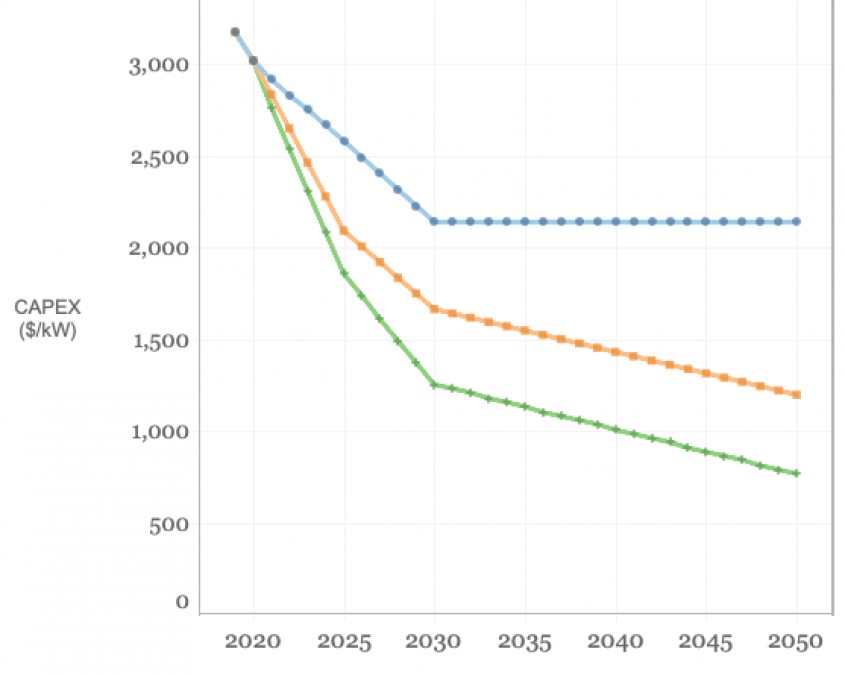The National Renewable Energy Laboratory (NREL) in the US has forecast dramatic cost reduction trends for battery energy storage to continue on a rapid trajectory to 2030 with reductions continuing at a slower pace through to 2050.
NREL has just published its annual technology baseline (ATB) report, which looks at both cost and performance of different electricity and transport technologies. Along with onshore and offshore wind, utility, commercial and residential solar PV and other technologies including fossil fuels, the laboratory has been adding a suite of energy storage technologies to its forecasting. Modelling comes from a range of sources synthesised by NREL’s experts, including data and analysis by BloombergNEF and numerous others.
For the first time, for 2021 it carries utility-scale PV-plus-battery, in addition to the continued inclusion of utility-scale battery storage, commercial battery storage and residential battery storage analysis, as well as pumped storage hydropower in terms of energy storage. Making the datasets it produces for electricity as well as transport technologies, NREL experts model three scenarios: conservative, moderate and advanced.
It looks at the pure R&D-based cost scenarios for the different technologies in terms of capital expenditure (CapEx), levelised cost of energy (LCOE), operations and maintenance (O&M), capacity factor and fixed charge rate. In addition to pure R&D, it also adds in financial scenarios that take into account possible market trends and policy dynamics, such as the addition or removal of tax incentives.
The representative technology chosen to figure out solar-plus-storage cost would be a DC-coupled system pairing single-axis utility-scale solar PV (130MWdc) with four-hour duration lithium-ion battery energy storage (50MWac / 200MWh), sharing a single bi-directional inverter (100MWac). NREL includes values for 10 different classes of technology, with Class 1 being most cost-effective and Class 10 the least.
It finds, for instance, that from an LCOE of US$46.448/MWh under an advanced scenario accounting for R&D, markets and policy dynamics in 2020 for a median (Class 5) PV-plus-battery system, by 2025 this could be US$32.758/MWh and then US$20.205/MWh by 2030, falling to US$14.45/MWh by 2050.
Under a conservative scenario, the fall in LCOE is more gradual but nonetheless picks up towards the middle of the century: it goes from US$47.255/MWh in 2020 to US$43.885/MWh in 2025, then US$43.441/MWh in 2030 and then falls sharply to US$26.732/MWh in 2050. The same system’s Capex under a moderate scenario goes from US$2015.886/kW in 2020 to US$1524.962/kW in 2025, then US$1034.038/kW by 2030 and US$827.703/kW by 2050.

LCOE was not modelled for utility-scale (standalone) battery storage, but Capex for a 4-hour battery was forecast to fall in a conservative scenario from US$1363.284/kW in 2020 to US$1317.725/kW this year, then US$1166.592/kW by 2025, then US$980.885/kW in 2030. NREL predicted from there that cost reduction would plateau and the Capex cost remain the same through to 2050 under the conservative scenario, although under the moderate and advanced scenarios that figure does continue to fall and becomes US$588.07/kW and US$345.73/kW respectively.
NREL also modelled the costs of 2-hour, 6-hour, 8-hour and 10-hour duration battery storage systems for utility-scale and found Capex cost to fall by a third even in the conservative scenario and halving in the advanced scenario between today and 2030.
Jason Burwen, interim CEO of the US national Energy Storage Association (ESA) noted yesterday on Twitter that by 2030, 10-hour batteries would cost the same as 4-hour batteries do today, according to the analysis. Burwen said that as costs fall, storage durations and project sizes will rise.
NREL’s work this year builds upon the lab’s ‘Storage futures study’, which it first presented in May that considers the applications and locations where a range of different energy storage technologies are cost-competitive with other energy system resources. NREL said that study, which is ongoing, analyses the “potentially fundamental role” of energy storage in the electric grid between now and 2050.
The NREL 2021 Annual Technology Baseline allows users of the datasets to input different variables to view cost reduction forecasts graphically and can be accessed and viewed here from the NREL website.


